Spatial Relationship between Eclogite and Copper-Nickel Mineralization in East Kunlun, China
Abstract
1. Introduction
2. Geologic Setting
3. Distribution Characteristics of Eclogite
3.1. Distribution Characteristics of Eclogite from Xiarihamu
3.2. Distribution Characteristics of Eclogite from Langmuri
4. Sample Collection and Methodology
4.1. Samples Collection
4.2. Experimental Procedure
4.2.1. Geochemical Analyses
4.2.2. Electron Probe Microanalysis
4.2.3. U-Pb Zircon Dating
5. Results
5.1. Petrography
5.1.1. Petrography of Eclogite from Xiarihamu
5.1.2. Petrography of Eclogite from Langmuri
5.2. Geochemistry
5.2.1. Major Elements
5.2.2. Rare Earth Elements (REEs)
5.2.3. Trace Elements
5.3. Mineral Chemistry
5.4. U-Pb Zircon Age
6. Discussion
6.1. Reconstruction of the Eclogite Protolith
6.2. Formation Environment of the Eclogite
6.3. Role of Eclogite in Metallogeny
7. Conclusions
Supplementary Materials
Author Contributions
Funding
Data Availability Statement
Acknowledgments
Conflicts of Interest
References
- Liu, Y.X.; Tang, H.S.; Wu, H.Z. Types and ore-control factors of Cu-Ni sulfide deposits in China. Miner. Resour. Geol. 1998, 64, 86–90. [Google Scholar]
- Li, X.H.; Su, L.; Chung, S.L.; Li, Z.X.; Liu, Y.; Song, B.; Liu, D.Y. Formation of the Jinchuan ultramafic intrusion and the world’s third largest Ni-Cu sulfide deposit: Associated with the 825 Ma south China mantle plume? Geochem. Geophys. Geosyst. 2005, 6, 1–16. [Google Scholar] [CrossRef]
- Tang, Z.L.; Yan, H.Q.; Jiao, J.G.; Pan, Z.X. Regional metallogenic controls of small-intrusion-hosted Ni-Cu(PGE) ore deposits in China. Earth Sci. Front. 2007, 14, 92–103. [Google Scholar] [CrossRef]
- Liu, Y.G.; Li, W.Y.; Jia, Q.Z.; Zhang, Z.W.; Wang, Z.A.; Zhang, Z.B.; Zhang, J.W.; Qian, B. The dynamic sulfide saturation process and a possible slab break-off model for the giant Xiarihamu magmatic nickel ore deposit in the East Kunlun orogenic belt, northern Qinghai-Tibet plateau, China. Econ. Geol. 2018, 113, 1383–1417. [Google Scholar] [CrossRef]
- Zhou, W.; Wang, B.Y.; Xia, M.Z.; Xia, Z.D.; Jiang, C.Y.; Dong, J.; Xie, E.S. Mineralogical characteristics of Shitoukengde mafic-ultramafic intrusion and analysis of its metallogenic potential, East Kunlun. Acta Petrol. Mineral. 2016, 35, 86–96. [Google Scholar]
- Zhang, Z.W.; Wang, Y.L.; Qian, B.; Liu, Y.G.; Qi, C.W.; Dong, J.; Yin, J.H. Mineralogical characteristics of the shitoukengde mafic-ultramafic intrusions in East Kunlun orogenic belt and the ore-forming indication. Geol. Explor. 2017, 53, 825–837. [Google Scholar]
- Shi, G.H.; Xiong, S.Y.; Li, Y.N.; Wang, Y.; Zhang, L.B. Analysis on prospecting potential of Langmuri Nickel polymetallic deposit in East Kunlun orogenic belt, Qinghai. Miner. Explor. 2018, 54, 1205–1211. [Google Scholar]
- Jia, L.H. Genesis of the Wenquan Ultramafic Rocks in East Kunlun Orogen, Northwest China; China University of Geosciences: Beijing, China, 2015; pp. 21–54. [Google Scholar]
- Kong, H.L.; Li, J.C.; Guo, X.Z.; Yao, X.G.; Jia, Q.Z. The discovery of Early Devonian pyroxene peridotete from the Xiwanggou magmatic NI-Cu sulfide ore spot in East Kunlun Mountains. Geol. China 2019, 46, 205–206. [Google Scholar]
- Qi, S.S.; Song, S.G.; Shi, L.C.; Cai, H.J.; Hu, J.C. Discovery and its geological significance of Early Paleozoic eclogite in Xiarihamu-Suhaitu area, western part of the East Kunlun. Acta Petrol. Sin. 2014, 30, 3345–3356. [Google Scholar]
- Zhang, Z.W.; Qian, B.; Li, W.Y.; Wang, Y.L.; Zhang, J.W.; You, M.X.; Liu, Y.G. The discovery of Early Paleozoic eclogite from the Xiarihamu magmatic Ni-Cu sulfide deposit in eastern Kunlun orogenic belt: Zircon U-Pb chronologic evidence. Geol. China 2017, 44, 816–817. [Google Scholar]
- Fan, Y.Z.; Meng, F.C.; Duan, X.P. The protoliths of the xiarihamu eclogites from the western part of east Kunlun and continent/arc-continent collision. Acta Geol. Sin. 2018, 92, 482–502. [Google Scholar]
- Du, W.; Jiang, C.Y.; Tang, Z.L.; Xia, M.Z.; Xia, Z.D.; Ling, J.L.; Zhou, W.; Wang, B.Y. Discovery of the Dagele Eclogite in East Kunlun, Western China and Its Zircon SHRIMP U-Pb Ages: New Constrains on the Central Kunlun Suture Zone. Acta Geol. Sin. 2017, 91, 1153–1154. [Google Scholar] [CrossRef]
- Guo, X.Z.; Jia, Q.Z.; Li, J.C.; Kong, H.L.; Yao, X.G.; Mi, J.R.; Qian, B.; Wang, Y. Zircon U-Pb geochronology and geochemistry and their geological significances of eclogites from east Kunlun high-pressure metamorphic belt. Earth Sci. 2018, 43, 4300–4318. [Google Scholar]
- Qi, X.P.; Fan, X.G.; Yang, J.; Cui, J.T.; Wang, B.Y.; Fan, Y.Z.; Yang, G.X.; Li, Z.; Chao, W.D. The discovery of Early Paleozoic eclogite in the upper reaches of Langmuri in eastern East Kunlun Mountains and its significance. Geol. Bull. China 2016, 35, 1771–1783. [Google Scholar]
- Meng, F.C.; Zhang, J.X.; Cui, M.H. The Discovery of Early Paleozoic eclogite from the East Kunlun, western China and its tectonic significance. Gondwana Res. 2013, 23, 825–836. [Google Scholar] [CrossRef]
- Meng, F.C.; Cui, M.H.; Jia, L.H.; Ren, Y.F.; Feng, H.B. Paleozoic continental collision of the East Kunlun orogen: Evidence from protoliths of the eclogites. Acta Petrol. Sin. 2015, 31, 3581–3594. [Google Scholar]
- Ma, C.Q.; Xiong, F.H.; Zhang, J.Y.; Liu, B.; Huang, J.; Jiang, H.A. Influence of subduction plate on magmatism from plate subduction to post-orogenic stage: Evidence from Early Permian to Late Triassic mafic dyke group in East Kunlun. Acta Geol. Sin. 2013, 87, 79–81. [Google Scholar]
- Wang, G.; Sun, F.Y.; Li, B.L.; Li, S.J.; Zhao, J.W.; Ao, C.; Yang, Q.A. Petrography, zircon U-Pb geochronology and geochemistry of the mafic-ultramafic intrusion in Xiarihamu Cu-Ni deposit from East Kunlun, with implications for geodynamic setting. Geosci. Front. 2014, 21, 381–401. [Google Scholar] [CrossRef]
- Zhang, Z.W.; Li, W.Y.; Qian, B.; Wang, Y.L.; Li, S.J.; Liu, C.Z.; Zhang, J.W.; Yang, Q.A.; You, M.X.; Wang, Z.A. Metallogenic epoch of the Xiarihamu magmatic Ni-Cu sulfide deposit in eastern Kunlun orogenic belt and its prospecting significance. Geol. China 2015, 42, 438–451. [Google Scholar]
- Pan, T. The prospecting for magmatic liquation type nickel deposits on the southern and northern margin of Qaidam Basin, Qinghai Province: A case study of the Xiarihamu Ni-Cu sulfide deposit. Geol. China 2015, 42, 713–723. [Google Scholar]
- Pan, T.; Li, S.P.; Zhao, C.X.; Chen, J.; Jin, T.T.; Lin, H. Metallogenic model and prospecting direction of the Xiarihamu Ni-Cu sulfide deposit in East Kunlun area. Geol. Bull. China 2017, 36, 1276–1287. [Google Scholar]
- Li, H.R.; Qian, Y.; Sun, F.Y.; Sun, J.L.; Wang, G. Zircon U–Pb dating and sulfide Re–Os isotopes of the Xiarihamu Cu–Ni sulfide deposit in Qinghai Province, Northwestern China. Can. J. Earth Sci. 2020, 57, 885–902. [Google Scholar] [CrossRef]
- Ren, J.S. The continental tectonics of China. Bull. Chin. Acad. Geol. Sci. 1994, Z2, 5–13. [Google Scholar] [CrossRef]
- Yin, H.F.; Zhang, K.X. Characteristics of the eastern Kunlun orogenic belt. Earth Sci. J. China Univ. Geosci. 1997, 22, 339–342. [Google Scholar]
- Jiang, C.F.; Wang, Z.Q.; Li, J.T. Opening and Closing Tectonics of the Central Asian Orogenic Belt; Geological Publishing House: Beijing, China, 2000; pp. 1–107. [Google Scholar]
- Xu, Z.Q.; Yang, J.S.; Li, H.B.; Zhang, J.X.; Zeng, L.L.; Jiang, M. The Qinghai-Tibet plateau and continental dynamics: A review on terrain tectonics, collisional orogenesis, and processes and mechanisms for the rise of the plateau. Geol. China 2006, 33, 221–238. [Google Scholar]
- Xu, W.Y.; Zhang, D.Q.; Yan, S.H.; Li, D.X.; Feng, C.Y.; She, H.Q.; Dong, Y.J. Advances and prospecting of the mineral resources survey in Eastern Kunlun Area. Geol. China 2001, 28, 25–29. [Google Scholar]
- Li, Z.M.; Xue, C.J.; Wang, X.H.; Tang, H.; Tu, Q.J.; Teng, J.X.; Li, R.S. Features of regional mineralizationg and analysis of the exploration development in the Eastern Kunlun mountains. Geol. Rev. 2007, 53, 708–718. [Google Scholar]
- Pan, T.; Bai, Y.S.; Sun, F.Y.; Chen, J.P. Metallogenic Series of East Kunlun Nonferrous and Precious Metal Ores in Qinghai Province; Geological Publishing House: Beijing, China, 2011; pp. 1–250. [Google Scholar]
- Pan, T. Classification of metallogenic units in Qinghai, China. J. Earch Sci. Environ. 2017, 39, 16–33. [Google Scholar]
- Yuan, W.M.; Mo, X.X.; Yu, X.H.; Luo, Z.H. The Record of Indosinian Tectonic Setting from the Granotoid of Eastern Kunlun Mountains. Geol. Rev. 2000, 46, 203–211. [Google Scholar]
- Mo, X.X.; Luo, Z.H.; Deng, J.F.; Yu, X.H.; Liu, C.D.; Shen, H.W.; Yuan, W.M.; Liu, Y.H. Granitoids and Crustal Growth in the East-Kunlun Orogenic Belt. Geol. J. China Univ. 2007, 13, 403–414. [Google Scholar]
- Pan, T. Discussion on ore controlling condition of Dulengou Cu-Co depoist in Eastern Kunlun metallogenic belt, Qinhai. Miner. Resour. Geol. 2004, 18, 109–112. [Google Scholar]
- Pan, T. Geochemical features and origin of siliceous rocks of Kendekeke Co-Au depoist in the eastern Kunlun metallogenic belt, Qinhai. Geol. Prospect. 2008, 44, 51–54. [Google Scholar]
- Pan, T. Discussion on the Minerogenetic Series of Deposits in Qinghai, China. J. Earth Sci. Environ. 2019, 41, 297–315. [Google Scholar]
- Li, S.J.; Sun, F.Y.; Gao, Y.W.; Zhao, J.W.; Li, L.S.; Yang, Q.A. The theoretical guidance and the practice of small intrusions forming large deposits—The enlightenment and significance for searching breakthrough of Cu-Ni sulfide deposit in Xiarihamu, East Kun lun, Qinghai. Northwestern Geol. 2012, 45, 185–191. [Google Scholar]
- Meng, Q.P. Study on Geological Characteristics and Genesis of Langmuri Copper-Nickel Deposit in Eastern Kunlun, Qinghai; Jilin University: Changchun, China, 2019; pp. 1–86. [Google Scholar]
- Ao, C.; Sun, F.Y.; Li, B.L.; Li, S.J.; Wang, G. Geochemistry, zircon U-Pb dating and geological significance of diorite porphyrite in Xiarihamu deposit, eastern Kunlun orogenic belt, Qinghai. Northwestern Geol. 2014, 47, 96–106. [Google Scholar]
- Yang, S.Y.; Jiang, S.Y.; Mao, Q.; Chen, Z.Y.; Rao, C.; Li, X.L.; Li, W.C.; Yang, W.Q.; He, P.L.; Li, X. Electron probe microanalysis in geosciences: Analytical procedures and recent advances. At. Spectrosc. 2022, 43, 186–200. [Google Scholar] [CrossRef]
- Hou, K.J.; Li, Y.H.; Tian, Y.R. In situ U-Pb zircon dating using laser ablation-multi ion counting-ICP-MS. Miner. Depos. 2009, 28, 481–492. [Google Scholar]
- Winchester, J.A.; Floyd, P.A. Geochemical discrimination of different magma series and theirdifferentiation products using immobile elements. Chem. Geol. 1977, 20, 325–343. [Google Scholar] [CrossRef]
- Muller, D.; Groves, D.I. Potassic Igneous Rocks and Associated Gold- Copper Mineralization; Springer: Berlin, Germany, 1995; pp. 1–144. [Google Scholar]
- Taylor, S.R.; McLennan, S.M. The Continental Crust: Its Composition and Evolution; Blackwell Scientific Publication: London, UK, 1985; p. 312. [Google Scholar]
- Sun, S.S.; McDonough, W.F. Chemical and isotopic systematics ofoceanic basalts: Implications for mantle composition and processes. Geol. Soc. Lond. Spec. Publ. 1989, 42, 313–345. [Google Scholar] [CrossRef]
- Taylor, S.R.; McLennan, S.M. The composition and evolution of the continental crust: Rare earth element evidence from sedimentary rocks. Philos. Trans. R. Soc. A 1981, 301, 381–399. [Google Scholar]
- Turekian, K.K.; Wedepohl, K.H. Distribution of the elements in some major units of the earth’s crust. Geol. Soc. Am. Bull. 1961, 72, 175–192. [Google Scholar] [CrossRef]
- Cong, B.L.; Zhang, W.H. Garnet of eclogite. Chin. Sci. Bull. 1977, 9, 413–416. [Google Scholar]
- Coleman, R.G.; Lee, D.E.; Beatty, L.B.; Brannock, W.W. Eclogites and eclogites: Their differences and similarities. Geoligical Soc. Am. Bull. 1965, 76, 483–508. [Google Scholar] [CrossRef]
- Lei, W.Y.; Shi, G.H.; Liu, Y.X. Research progress on trace element characteristics of zircons of different origins. Earth Sci. Front. 2013, 20, 273–284. [Google Scholar]
- Mahdy, N.M.; Baher, A.; El Kalioubi, B.A.; Wohlgemuth-Ueberwasser, C.C.; Shalaby, M.H.; El-Afandy, A.H. Petrogenesis of U- and Mo-bearing A2-type granite of the Gattar batholith in the Arabian Nubian Shield, Northeastern Desert, Egypt: Evidence for the favorability of host rocks for the origin of associated ore deposits. Ore Geol. Rev. 2015, 75, 57–81. [Google Scholar] [CrossRef]
- Mahdy, N.M. Textural and chemical characteristics of zircon, monazite, and thorite, Wadi Al-Baroud area, Eastern Desert of Egypt: Implication for rare metal pegmatite genesis. Ore Geol. Rev. 2021, 136, 104225. [Google Scholar] [CrossRef]
- Belousova, E.A.; Griffin, W.L.; O’Reilly, S.Y.; Fisher, N.I. Igneous zircon: Trace element composition as an indicator of source rock type. Contrib. Mineral. Petrol. 2002, 143, 602–622. [Google Scholar] [CrossRef]
- Guo, X.; Yan, Z.; Fu, C.; Wang, Z. Formation age and tectonic attribute of jinshuikou group complex in the Nanshan area, Qinghai. Acta Geol. Sin. 2016, 90, 589–606. [Google Scholar]
- Lu, S.N.; Li, H.C.; Wang, H.C.; Chen, Z.H.; Zheng, J.K.; Xiao, Z.Q. Detrital zircon population of Proterozoic meta-sedimentary strata in the Qinling-Qilian-Kunlun Orogen. Acta Petrol. Sin. 2009, 25, 2195–2208. [Google Scholar]
- Li, M.; Zha, X.F.; Hu, C.B.; Gao, X.F.; Li, T.; Yao, Z.L. Zircon U-Pb geochronology of the Baishahe Formation in the western part of East Kunlun Orogenic Belt: Constraints on Precambrian basement evolution. Geol. Bull. China 2021, 40, 41–57. [Google Scholar]
- Wetherill, G.W. Discordant uranium-lead ages. Trans. Am. Geophys. Union 1956, 37, 320–326. [Google Scholar] [CrossRef]
- Hoskin, P.W.O.; Black, L.P. Metamorphic zircon formation by solid-state recrystallization of protolith igneous zircon. Meta-morphic Geol. 2000, 18, 423–439. [Google Scholar] [CrossRef]
- Geisler, T.; Ulonska, M.; Schleicher, H.; Pidgeon, R.T.; Bronswijk, W.V. Leaching and differential recrystallization of metamict zircon under experimental hydrothermal condition. Contrib Miner. Pet. 2001, 141, 53–65. [Google Scholar] [CrossRef]
- Zhang, Y.Q. Effect of radiogenic lead loss in zircon on in-situ U-Pb dating and data correction method. J. Geol. 2015, 89, 62–63. [Google Scholar]
- Bernard, G.J.; Cornichet, J. Origin of eclogites from South Brittany, France: A Sm-Nd isotopic and REE study. Chem. Geol. Isot. Geosci. Sect. 1985, 52, 185–201. [Google Scholar] [CrossRef]
- Jahn, B.M.; Rumble, D.; Liou, J.G. Geochemistry and isotope tracer study of UHP metamorphic rocks//Ultrahigh Pressure Metamorphism. EMU Notes Mineral. 2003, 32, 365–414. [Google Scholar]
- Zheng, Y.F. Metamorphic chemical geodynamics in continental subduction zones. Chem. Geol. 2012, 328, 5–48. [Google Scholar] [CrossRef]
- Wang, H.; Wu, Y.B.; Gao, S.; Liu, X.C.; Liu, Q.; Qin, Z.W.; Xie, S.W.; Zhou, L.; Yang, S.H. Continental origin of eclogites in the North Qinling terrane and its tectonic implications. Precambrian Res. 2013, 230, 13–30. [Google Scholar] [CrossRef]
- Dong, Y.H.; Wang, Q.; Xu, J.F.; Zi, F. Dongyue Lake adakitic volcanic rocks with high Mg# in north Qiangtang block: Petrogenesis and its tectonic implication. Acta Petrol. Sin. 2008, 24, 291–302. [Google Scholar]
- Niu, Y.N. Generation and evolution of basaltic magmas: Some basic concepts and a new view on the origin of mesozoic-cenozoic basaltic volcanism in Eastern China. Geol. J. China Univ. 2005, 11, 9–46. [Google Scholar]
- Vervoot, J.D.; Pachelt, P.J.; Gehres, G.; Nutman, A.P. Constraints on early Earth differentiation from Hafnium and Neodymium isotopes. Nature 1996, 379, 624–627. [Google Scholar] [CrossRef]
- Fan, J.T.; Cheng, Z.X. HP-UHP metamorphism and deformation in Northern Jiangsu and its metallogeny. Geotecton. Metallog. 1998, 22, 65–74. [Google Scholar]
- Lu, S.N. Preliminary Study on Precambrian Geology in the Northern Qinghai-Tibet Plateau; Geological Publishing House: Beijing, China, 2002; pp. 1–125. [Google Scholar]
- Wang, G.C.; Wang, Q.H.; Jian, P.; Zhu, Y.H. Zircon SHRIMP ages of Precambrian metamorphic basement rocks and their tectonic significance in the eastern Kunlun Mountains, Qinghai Province, China. Geosci. Front. 2004, 11, 481–490. [Google Scholar]
- Condie, K.C. Continent grouping during formation of Rodinia at 1.35-0.9Ga. Gondwana Res. 2001, 4, 5–16. [Google Scholar] [CrossRef]
- Chen, Y.X.; Pei, X.Z.; Li, Z.C.; Li, R.B.; Liu, C.J.; Chen, G.C.; Pei, L.; Wei, B. Geochronology, geochemical features and geological significance of the granitic gneiss in Balong area, East Section of East Kunlun. Acta Petrol. Sin. 2015, 31, 2230–2244. [Google Scholar]
- Lu, S.N. A Review of Advance in the Research on the Neoproterozoic Rodinia Supercontinent. Geol. Rev. 1998, 44, 489–495. [Google Scholar]
- Lu, S.N. From Rodinia to Gondwanaland Supercontinents—Thinking about problems of researching neoproterozoic supercontinents. Earth Sci. Front. 2001, 8, 441–448. [Google Scholar]
- Ren, J.H.; Zhang, K.; Liu, Y.Q.; Zhou, D.W.; Feng, Q. Geochemical characteristics and zircon dating of blasto-gabrro from the South Jinshuikou area, Eastern Kunlun. Journal of Northwest University. 2011, 41, 100–106. [Google Scholar]
- Yang, J.S.; Robinson, P.T.; Jiang, C.F.; Xu, Z.Q. Ophiolites of the Kunlun Mountains. China and their tectonic implications. Tectonophysics 1996, 258, 215–231. [Google Scholar] [CrossRef]
- Li, H.K.; Lu, S.N.; Xiang, Z.Q.; Zhou, H.Y.; Guo, H.; Song, B.; Zheng, J.K.; Gu, Y. SHRIMP U-Pb zircon age of the granulite from the Qingshuiquan area, Central Eastern Kunlun Suture Zone. Arth Sci. Front. 2006, 13, 311–321. [Google Scholar]
- Zhang, Y.F.; Pei, X.Z.; Ding, S.P.; Li, R.B.; Feng, J.B.; Sun, Y.; Li, Z.C.; Chen, Y.; Chen, Y.X. LA-ICP-MS zircon U-Pb age of quartz diorite at the Kekesha area of Dulan County, eastern section of the East Kunlun orogenic belt, China and its significance. Geol. Bull. China 2010, 29, 79–85. [Google Scholar]
- Liu, B.; Ma, C.Q.; Zhang, J.Y.; Xiong, F.H.; Huang, J.; Jiang, H.A. Petrogenesis of Early Devonian intrusive rocks in the east part of Eastern Kunlun Orogen and implication for Early Palaeozoic orogenic processes. Acta Petrol. Sin. 2012, 28, 1785–1807. [Google Scholar]
- Zhao, Z.M.; Ma, H.D.; Wang, B.Z.; Bai, Y.S.; Li, R.S.; Ji, W.H. The evidence of intrusive rocks about collision-orogeny during early devonian in Eastern Kunlun Area. Geol. Rev. 2008, 54, 1–11. [Google Scholar]
- Yu, S.Y.; Zhang, J.X.; Li, H.K.; Hou, K.J.; Mattinson, C.G.; Gong, J.H. Geochemistry, zircon U-Pb geochronology and Lu-Hf isotopic composition of eclogites and their host gneisses in the Dulan area, North Qaidam UHP terrane: New evidence for deep continental subduction. Gondwana Res. 2013, 23, 901–919. [Google Scholar] [CrossRef]
- Amelin, Y.; Lee, D.C.; Halliday, A. Early-middle Archaean crustal evolution deduced from Lu-Hf and U-Pb isotopic studies of single zircon grains. Geochim. Cosmochim. Acta 2000, 64, 4205–4225. [Google Scholar] [CrossRef]
- Zhang, C.; Zhang, L.F.; Bader, T.; Song, S.G.; Lou, Y.X. Geochemistry and trace element behaviors of eclogite during its exhumation in the Xitieshan terrane, North Qaidam UHP belt, NW China. J. Asian Earth Sci. 2013, 63, 81–97. [Google Scholar] [CrossRef]
- Bai, Y.; Guo, Z.P.; Zhao, X.M. Geochronology, Hf isotopic and geochemical characteristics of Maozang granodiorite in Langlike area, North Qilian Mountain. Miner. Depos. 2017, 36, 158–170. [Google Scholar]
- Yin, H.F.; Zhang, K.X. Evolution and Characteristics of the central orogenic belt. Earth Sci. J. China Univ. Geosci. 1998, 23, 437–442. [Google Scholar]
- Carswell, D.A.; Harly, S.I. Mineral Barometry and Thermometry//Carswell D A. Eclogite Facies Rocks; Chapman and Hall: New York, NY, USA, 1990; pp. 83–110. [Google Scholar]
- Lu, C.Z.; Yan, T.Z.; Dong, C.W.; Gu, M.G. Magmatic consanguinity analysis of the Muchen intrusion and Xishantou Formation volcanic rocks in Zhejiang. Geol. China 2006, 33, 146–152. [Google Scholar]
- Wang, M.; Li, C.; Zhai, Q.G.; Xie, C.M.; Wu, Y.W. Magma homology of mafic dyke and basalt in southern Qiangtang, northern Tibet, China. Geol. Bull. China 2009, 28, 1281–1289. [Google Scholar]
- Duan, X.P.; Meng, F.C.; Fan, Y.Z. The constraints of kaersutite and pargasite on metallogeny in Xiarihamu mafic-ultramafic intrusion, East Kunlun. Acta Petrol. Sin. 2019, 35, 1819–1832. [Google Scholar]
- Du, W.; Ling, J.L.; Zhou, W.; Wang, Z.X.; Xia, Z.D.; Xia, M.Z.; Fan, Y.Z.; Jiang, C.Y. Geological characteristics and genesis of Xiarihamu nickel deposit in East Kunlun. Miner. Depos. 2014, 33, 713–726. [Google Scholar]
- Zhao, Z.F.; Zheng, Y.F.; Zhang, J.; Dai, L.Q.; Li, Q.; Liu, X. Syn-exhumation magmatism during continental collision: Evidence from alkaline intrusives of Triassic age in the Sulu orogen. Chem. Geol. 2012, 328, 70–88. [Google Scholar] [CrossRef]
- Zhao, Z.F.; Dai, L.Q.; Zheng, Y.F. Postcollisional mafic magmatism records the crust-mantle interaction of continental subduction-zone. Chin. Sci. Bull. 2013, 58, 2310–2315. [Google Scholar]
- Zheng, Y.F.; Zhao, Z.F.; Chen, Y.X. Continental subduction channel processes: Plate interface interaction during continental collision. Chin. Sci. Bull. 2013, 58, 2233–2239. [Google Scholar] [CrossRef]
- Zheng, Y.F.; Chen, Y.X. Crust-mantle interaction in continental subduction zones. Earth Sci. 2019, 44, 3961–3983. [Google Scholar]
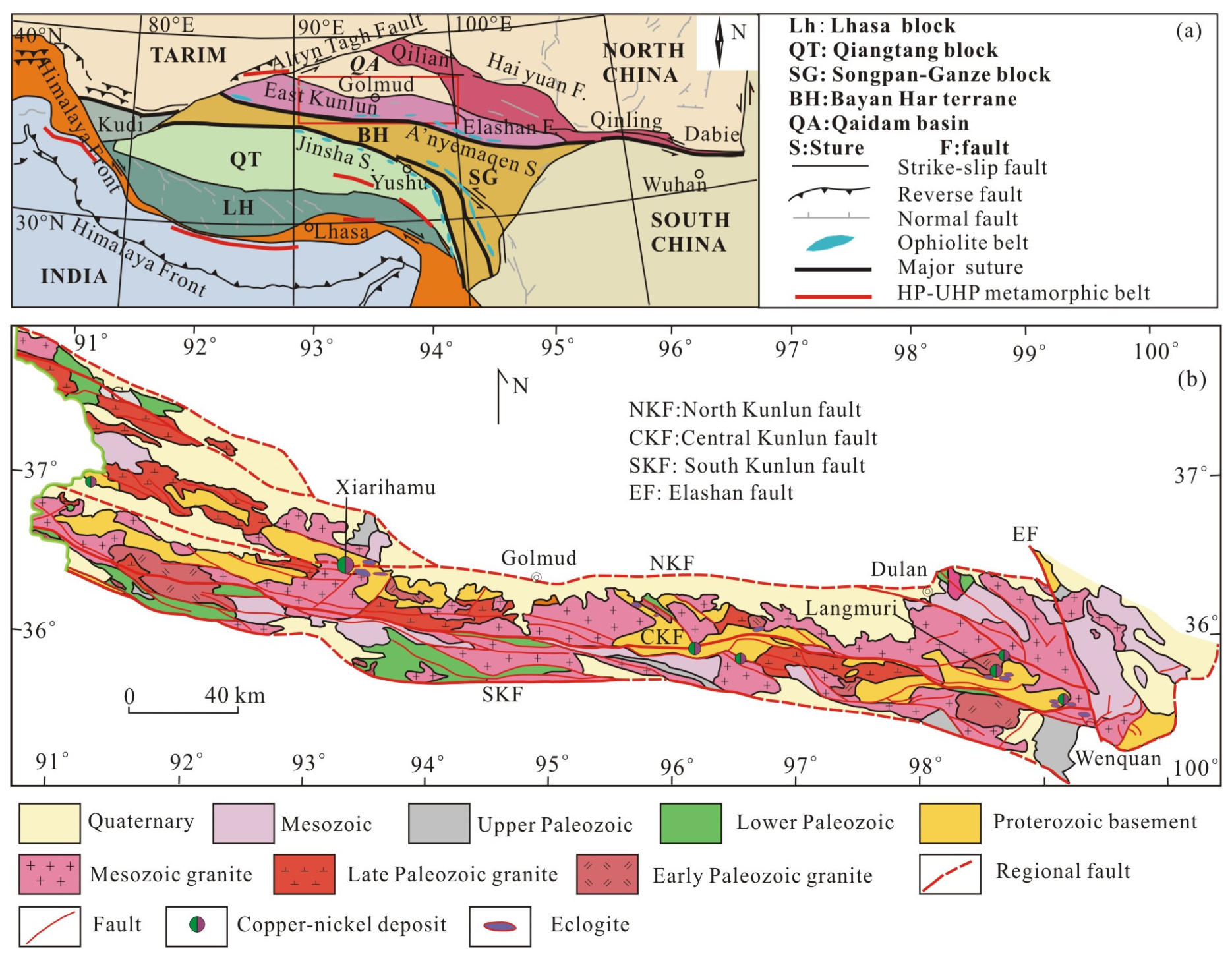

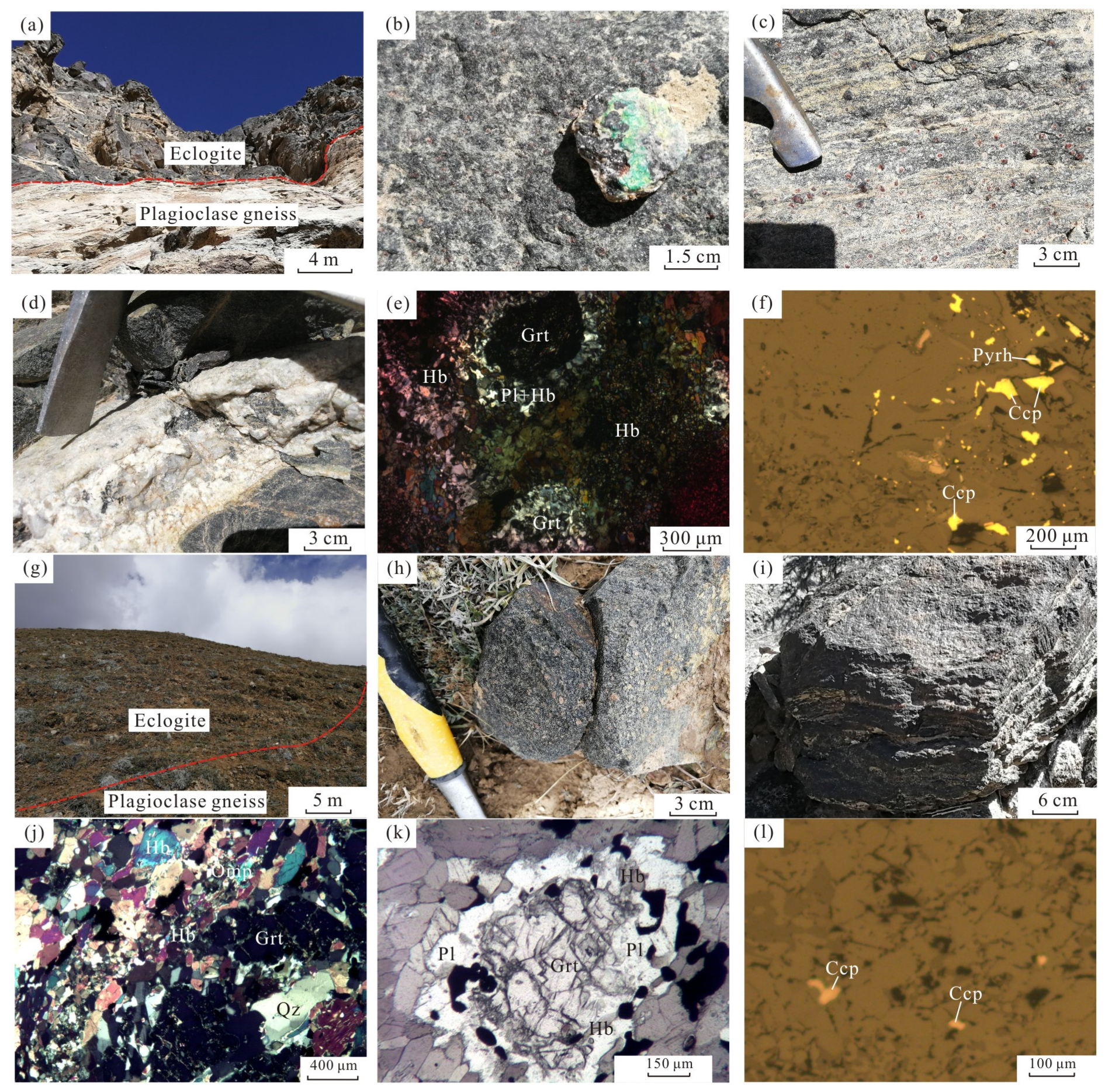
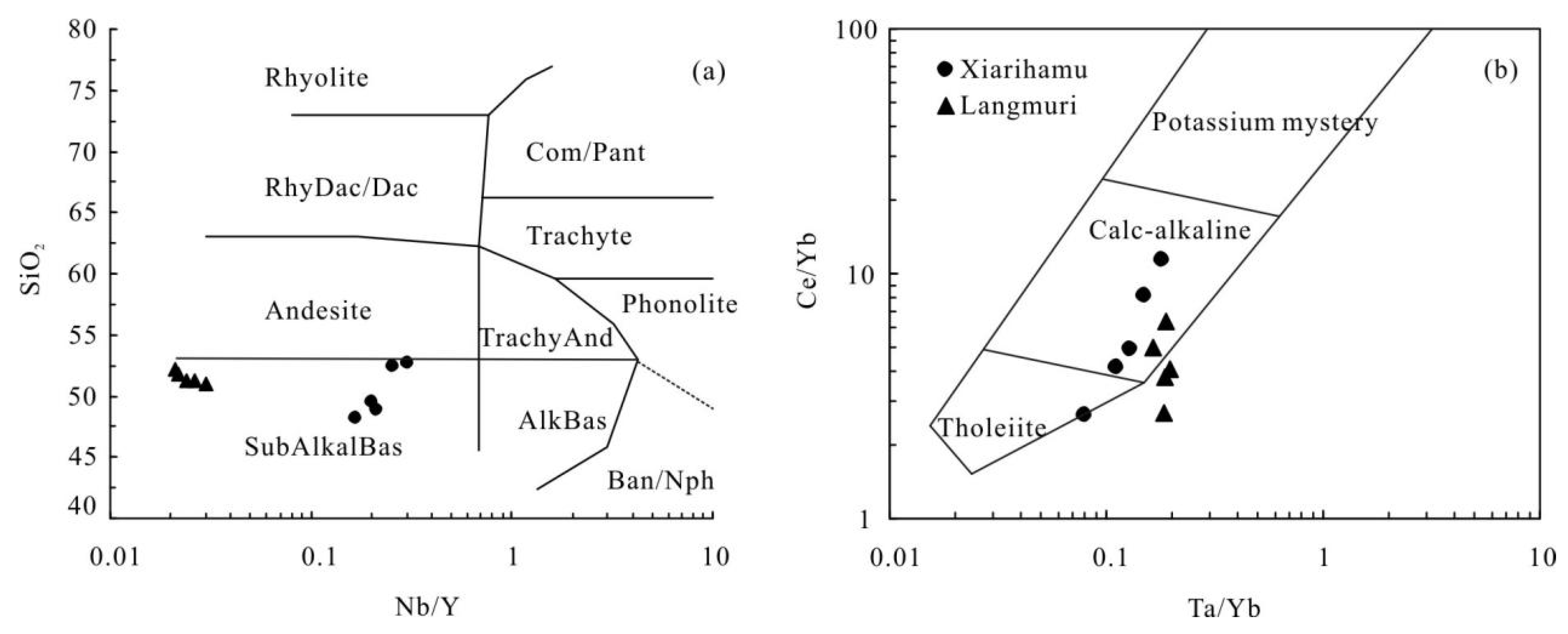
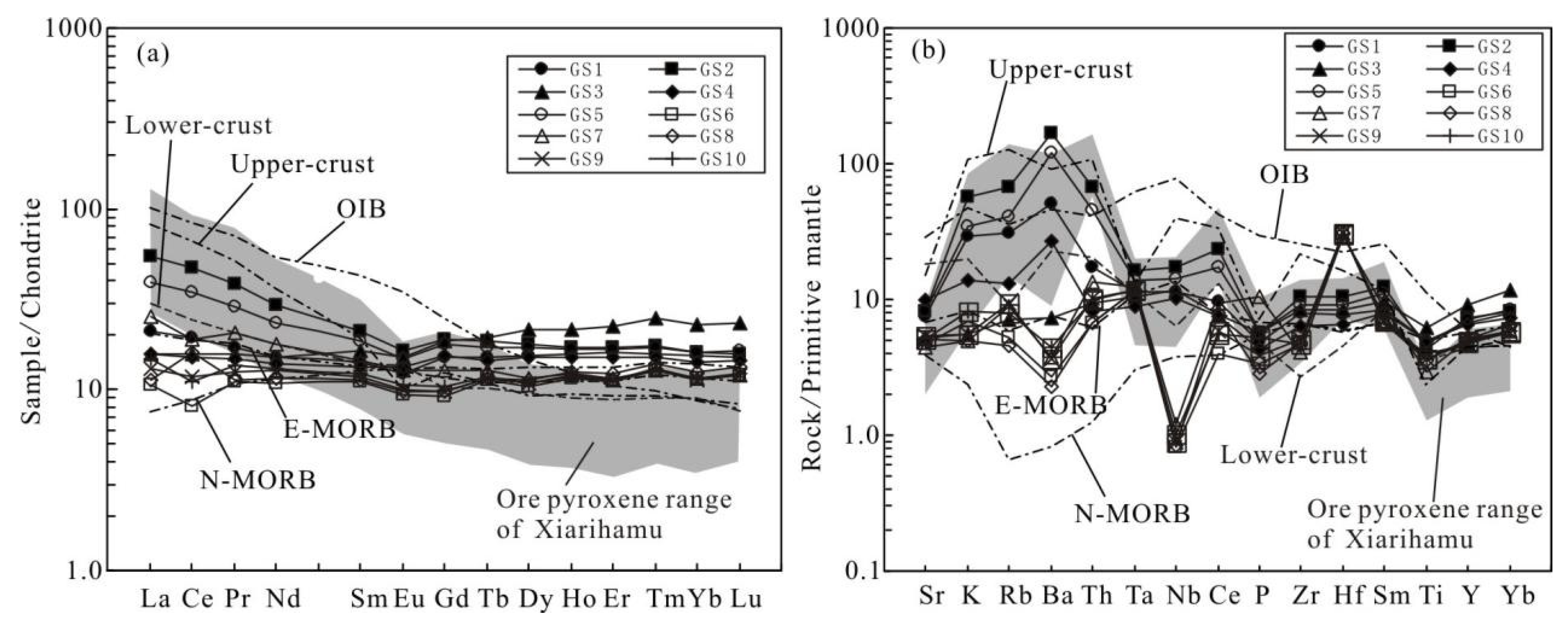
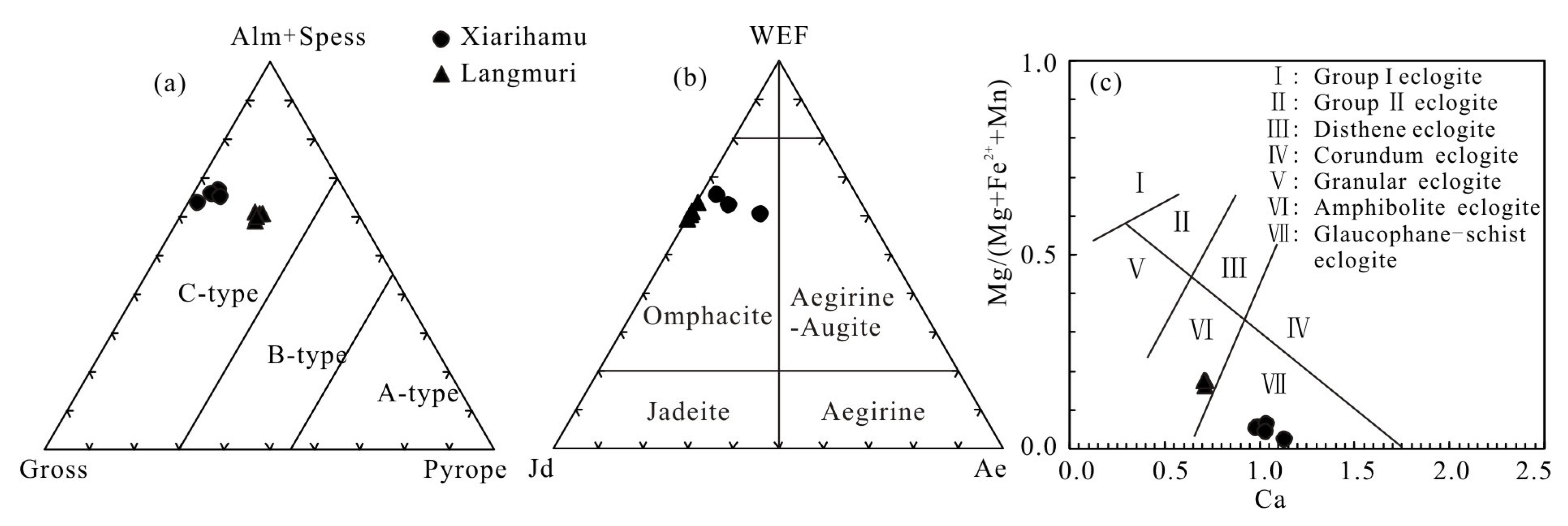
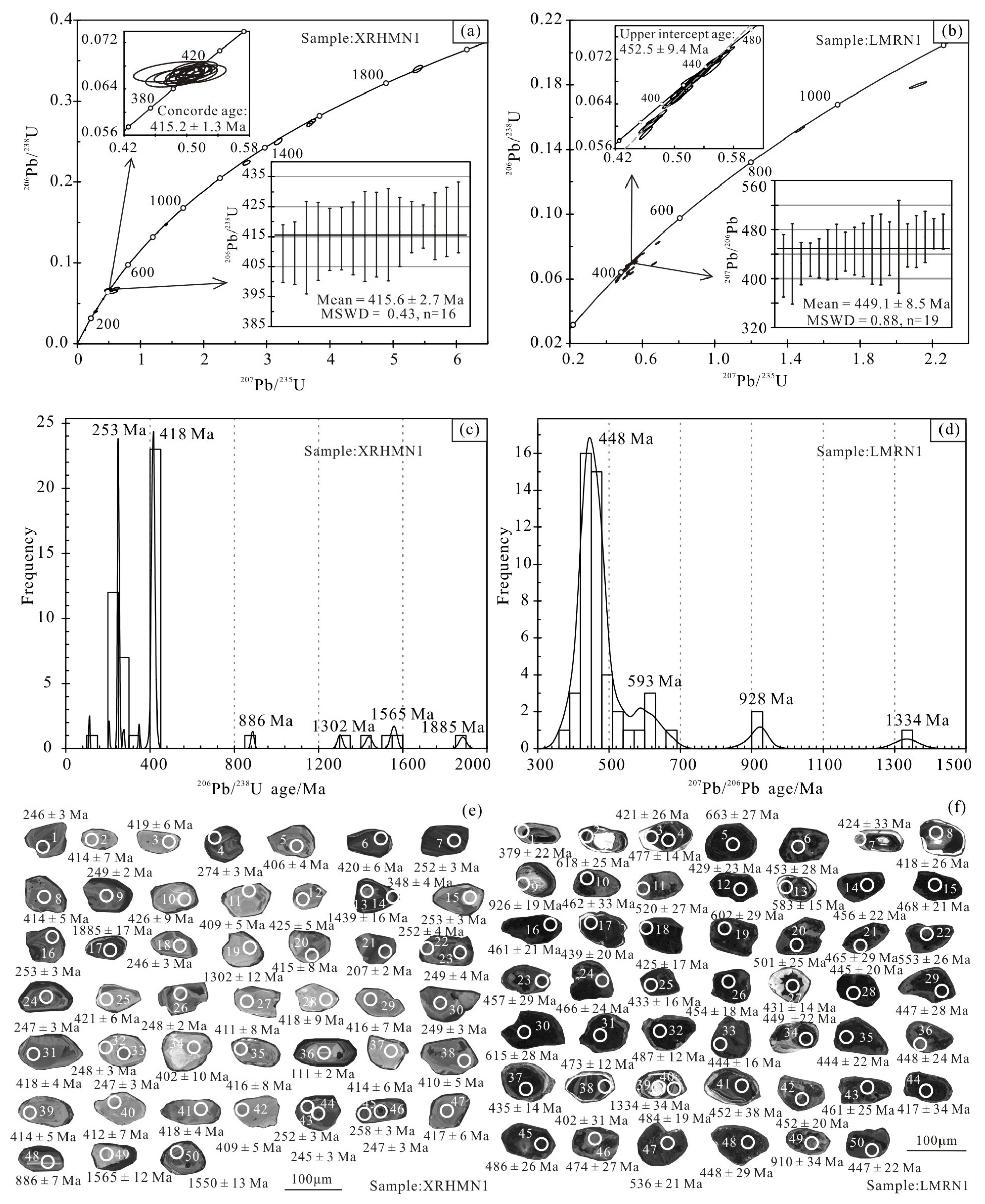
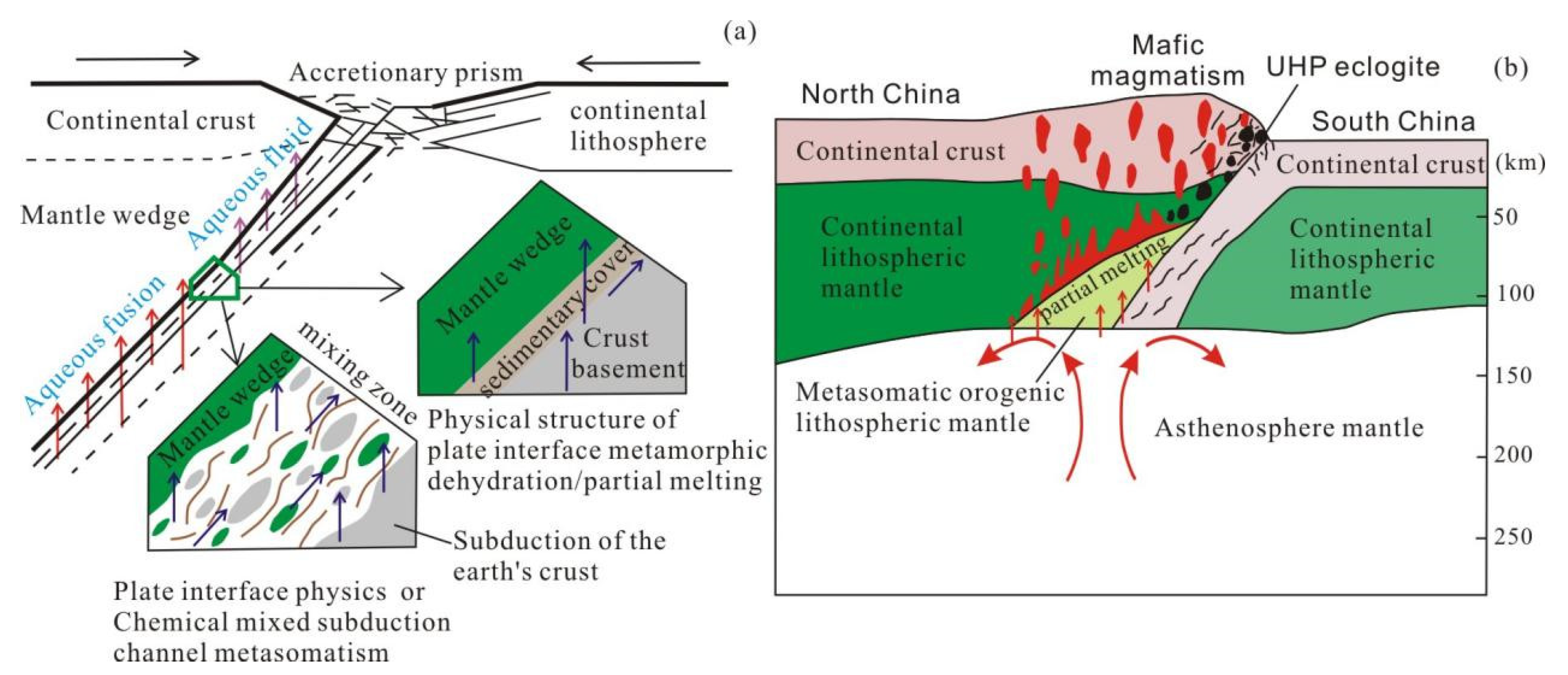

| Sample | Type | Weight | Area | Coordinates | Description |
|---|---|---|---|---|---|
| XRHMN1 | U-Pb zircon | 31 kg | Xiarihamu | 93°24′21″ E, 36°26′50″ N | Collected intact and fresh rocks, dark grayish-green in color, composed of omphacite, garnet, plagioclase, hornblende, quartz, and biotite. |
| GS1–GS5 | Whole-rock analyses | ~1 kg | |||
| DZ1-DZ2 | EPMA | ~0.5 kg | |||
| LMRN1 | U-Pb zircon | 35 kg | Langmuri | 98°36′29″ E, 35°44′41″ N | Collected intact and fresh rocks, dark grayish-green in color, composed of omphacite, garnet, plagioclase, quartz, hornblende, and rutile. |
| GS6–GS10 | Whole-rock analyses | ~1 kg | |||
| DZ3-DZ4 | EPMA | ~0.5 kg |
| Sample | GS1 | GS2 | GS3 | GS4 | GS5 | GS6 | GS7 | GS8 | GS9 | GS10 |
|---|---|---|---|---|---|---|---|---|---|---|
| area | Xiarihamu | Langmuri | ||||||||
| SiO2 | 47.56 | 50.82 | 47.57 | 48.86 | 51.32 | 50.79 | 52.16 | 52.32 | 49.63 | 50.54 |
| Al2O3 | 12.48 | 12.70 | 13.53 | 13.21 | 12.82 | 11.79 | 12.81 | 11.18 | 11.66 | 12.37 |
| Fe2O3 | 1.30 | 1.11 | 2.18 | 1.89 | 1.41 | 0.24 | 0.1 | 0.13 | 0.24 | 0.1 |
| FeO | 11.50 | 9.42 | 13.55 | 11.12 | 9.83 | 12.31 | 11.83 | 12.39 | 12.83 | 12.34 |
| MgO | 6.32 | 6.32 | 6.35 | 6.55 | 6.31 | 10.35 | 9.64 | 10.17 | 10.87 | 10.31 |
| CaO | 13.50 | 10.44 | 10.92 | 12.38 | 11.01 | 11.12 | 11.03 | 10.86 | 10.52 | 10.73 |
| Na2O | 2.07 | 2.24 | 2.51 | 2.57 | 2.35 | 1.26 | 1.09 | 1.09 | 0.95 | 1.11 |
| K2O | 0.90 | 1.76 | 0.17 | 0.42 | 1.07 | 0.21 | 0.15 | 0.15 | 0.17 | 0.25 |
| TiO2 | 1.26 | 1.12 | 1.59 | 1.26 | 1.21 | 1.01 | 0.76 | 0.91 | 0.95 | 0.93 |
| P2O5 | 0.10 | 0.12 | 0.12 | 0.09 | 0.12 | 0.07 | 0.22 | 0.06 | 0.12 | 0.11 |
| MnO | 0.26 | 0.46 | 0.31 | 0.21 | 0.37 | 0.21 | 0.21 | 0.22 | 0.33 | 0.32 |
| LOI | 2.67 | 3.24 | 1.61 | 2.18 | 2.28 | 0.37 | 0.29 | 0.49 | 0.51 | 0.48 |
| Total | 99.92 | 99.75 | 100.41 | 100.74 | 100.1 | 99.73 | 100.29 | 99.97 | 98.78 | 99.59 |
| m/f | 0.87 | 1.04 | 0.72 | 0.90 | 0.98 | 1.46 | 1.38 | 1.53 | 1.48 | 1.43 |
| Mg# | 47.1 | 51.7 | 41.9 | 47.3 | 50.0 | 59.32 | 58.80 | 61.24 | 60.21 | 59.00 |
| La | 7.7 | 19.9 | 5.8 | 5.8 | 14.3 | 3.85 | 9.32 | 4.09 | 4.80 | 5.45 |
| Ce | 18.4 | 44.7 | 14.9 | 14.4 | 32.7 | 7.65 | 17.99 | 15.26 | 11.32 | 10.64 |
| Pr | 2.34 | 5.22 | 2.16 | 2.02 | 3.92 | 1.50 | 2.78 | 1.54 | 1.72 | 1.87 |
| Nd | 10.7 | 20.7 | 10.6 | 9.90 | 16.5 | 7.69 | 12.73 | 8.19 | 9.01 | 9.26 |
| Sm | 3.27 | 4.85 | 3.78 | 3.07 | 4.29 | 2.54 | 3.34 | 2.61 | 2.70 | 2.80 |
| Eu | 1.07 | 1.41 | 1.31 | 1.15 | 1.28 | 0.81 | 1.11 | 0.84 | 0.86 | 0.92 |
| Gd | 4.57 | 5.79 | 5.63 | 4.74 | 5.46 | 2.81 | 3.88 | 2.97 | 3.00 | 3.15 |
| Tb | 0.87 | 1.07 | 1.12 | 0.84 | 0.99 | 0.65 | 0.74 | 0.67 | 0.67 | 0.68 |
| Dy | 5.89 | 6.70 | 8.10 | 5.68 | 6.45 | 3.95 | 4.41 | 4.25 | 4.10 | 4.12 |
| Ho | 1.34 | 1.45 | 1.83 | 1.29 | 1.42 | 0.98 | 1.04 | 1.06 | 1.02 | 1.00 |
| Er | 3.94 | 4.25 | 5.52 | 3.71 | 4.15 | 2.73 | 2.84 | 3.07 | 2.81 | 2.79 |
| Tm | 0.56 | 0.62 | 0.87 | 0.54 | 0.61 | 0.45 | 0.45 | 0.49 | 0.45 | 0.46 |
| Yb | 3.77 | 3.95 | 5.68 | 3.48 | 3.99 | 2.83 | 2.82 | 3.11 | 2.77 | 2.82 |
| Lu | 0.57 | 0.60 | 0.88 | 0.55 | 0.62 | 0.46 | 0.46 | 0.51 | 0.46 | 0.47 |
| Y | 33.4 | 35.4 | 44.6 | 31.8 | 35.0 | 22.97 | 25.04 | 25.21 | 23.44 | 24.10 |
| ΣREE | 64.99 | 121.21 | 68.18 | 57.17 | 96.68 | 38.90 | 63.91 | 48.66 | 45.69 | 46.43 |
| LREE/HREE | 2.02 | 3.96 | 1.30 | 1.74 | 3.08 | 1.62 | 2.84 | 2.02 | 1.99 | 2.00 |
| (La/Yb)N | 1.38 | 3.40 | 0.69 | 1.13 | 2.42 | 0.92 | 2.23 | 0.89 | 1.17 | 1.31 |
| δEu | 0.85 | 0.81 | 0.87 | 0.92 | 0.81 | 0.92 | 0.94 | 0.92 | 0.92 | 0.94 |
| δCe | 1.01 | 1.01 | 0.99 | 0.99 | 1.01 | 0.75 | 0.82 | 1.42 | 0.92 | 0.78 |
| Rb | 27.1 | 59.1 | 6.1 | 11.4 | 35.7 | 4.49 | 7.61 | 3.91 | 8.20 | 6.92 |
| Ba | 392 | 1286 | 55 | 203 | 909 | 20.29 | 28.81 | 17.59 | 27.91 | 33.78 |
| Th | 1.69 | 6.47 | 0.91 | 0.79 | 4.36 | 0.66 | 1.32 | 0.66 | 0.98 | 0.97 |
| Ta | 0.49 | 0.71 | 0.45 | 0.39 | 0.60 | 0.51 | 0.53 | 0.51 | 0.51 | 0.51 |
| Nb | 7.10 | 10.7 | 7.40 | 6.40 | 8.98 | 0.51 | 0.75 | 0.53 | 0.56 | 0.63 |
| Hf | 2.70 | 3.70 | 3.00 | 2.30 | 3.20 | 10.85 | 10.43 | 10.86 | 10.86 | 10.68 |
| Zr | 89.0 | 117 | 93.0 | 71.0 | 101.8 | 51.93 | 45.15 | 52.80 | 55.94 | 52.33 |
| Sr | 172.0 | 190.0 | 122.0 | 230 | 191.6 | 110.00 | 103.95 | 119.38 | 124.47 | 117.16 |
| P | 436 | 524 | 524 | 393 | 524 | 306.63 | 962.18 | 260.16 | 349.26 | 480.33 |
| Cr | 110 | 140 | 90 | 110 | 116 | 312.64 | 342.09 | 350.21 | 292.28 | 309.25 |
| Cs | 2.91 | 4.60 | 1.17 | 1.73 | 2.99 | 0.18 | 0.43 | 0.18 | 0.31 | 0.30 |
| Sc | 43.3 | 32.7 | 50.9 | 44.0 | 37.6 | 51.38 | 52.63 | 56.25 | 46.54 | 49.85 |
| V | 472 | 382 | 596 | 478 | 430 | 293.73 | 288.04 | 293.60 | 267.88 | 282.30 |
| Ga | 17.0 | 19.7 | 17.0 | 18.9 | 18.1 | 0.53 | 1.06 | 0.53 | 0.80 | 3.27 |
| No | SiO2 | TiO2 | Al2O3 | FeO | MnO | MgO | Cr2O3 | CaO | Na2O | K2O | P2O5 | V2O3 | Total | Property |
|---|---|---|---|---|---|---|---|---|---|---|---|---|---|---|
| Xiarihamu | ||||||||||||||
| 1 | 36.67 | 0.08 | 20.44 | 30.22 | 0.10 | 1.46 | 0.04 | 11.63 | 0.01 | 0.01 | 0.00 | 0.00 | 100.64 | Garnet |
| 2 | 37.12 | 0.04 | 20.23 | 30.22 | 0.16 | 1.31 | 0.03 | 11.51 | 0.09 | 0.00 | 0.05 | 0.04 | 100.79 | Garnet |
| 3 | 37.34 | 0.05 | 20.29 | 28.44 | 0.38 | 0.60 | 0.02 | 13.28 | 0.00 | 0.00 | 0.06 | 0.02 | 100.46 | Garnet |
| 4 | 36.74 | 0.05 | 20.04 | 29.60 | 0.11 | 1.58 | 0.03 | 12.08 | 0.05 | 0.00 | 0.03 | 0.02 | 100.33 | Garnet |
| 5 | 36.37 | 0.08 | 20.45 | 29.72 | 0.24 | 1.07 | 0.00 | 11.93 | 0.02 | 0.00 | 0.00 | 0.02 | 99.89 | Garnet |
| 6 | 55.47 | 0.07 | 7.38 | 5.54 | 0.02 | 10.48 | 0.02 | 15.91 | 4.92 | 0.02 | 0.01 | 0.02 | 99.86 | Omphacite |
| 7 * | 54.69 | 0.14 | 7.80 | 5.33 | 0.06 | 9.98 | 0.03 | 15.80 | 5.30 | 0.00 | / | / | 99.13 | Omphacite |
| 8 * | 53.99 | 0.16 | 8.10 | 5.09 | 0.02 | 10.10 | 0.06 | 15.94 | 5.69 | 0.01 | / | / | 99.16 | Omphacite |
| 9 | 51.34 | 0.00 | 0.22 | 11.56 | 0.02 | 10.55 | 0.03 | 23.93 | 0.21 | 0.00 | 0.03 | 0.03 | 97.91 | Diopside |
| 10 | 54.06 | 0.11 | 1.14 | 0.66 | 0.17 | 16.50 | 0.00 | 25.65 | 0.24 | 0.01 | 0.01 | 0.86 | 99.43 | Diopside |
| 11 | 53.19 | 0.02 | 30.27 | 0.20 | 0.01 | 0.00 | 0.00 | 12.45 | 3.86 | 0.02 | 0.00 | 0.00 | 100.01 | Plagioclase |
| 12 | 53.55 | 0.00 | 29.96 | 0.10 | 0.00 | 0.01 | 0.00 | 11.98 | 4.11 | 0.02 | 0.00 | 0.02 | 99.75 | Plagioclase |
| 13 | 60.96 | 0.04 | 24.98 | 0.36 | 0.02 | 0.01 | 0.00 | 6.61 | 7.00 | 0.04 | 0.00 | 0.00 | 100.02 | Plagioclase |
| 14 | 55.36 | 0.00 | 27.33 | 0.20 | 0.05 | 0.00 | 0.03 | 11.77 | 4.74 | 0.06 | 0.00 | 0.04 | 99.58 | Plagioclase |
| 15 | 59.05 | 0.02 | 24.96 | 0.10 | 0.02 | 0.00 | 0.00 | 8.08 | 7.01 | 0.08 | 0.01 | 0.01 | 99.34 | Plagioclase |
| Langmuri | ||||||||||||||
| 16 | 38.22 | 0.10 | 20.95 | 27.16 | 0.55 | 4.34 | 0.00 | 8.47 | 0.02 | 0.00 | 0.01 | 0.07 | 99.89 | Garnet |
| 17 | 37.47 | 0.11 | 21.30 | 27.73 | 0.62 | 4.54 | 0.03 | 8.62 | 0.03 | 0.00 | 0.00 | 0.01 | 100.46 | Garnet |
| 18 | 37.20 | 0.07 | 21.75 | 27.96 | 0.63 | 4.20 | 0.00 | 8.54 | 0.02 | 0.01 | 0.01 | 0.00 | 100.39 | Garnet |
| 19 | 37.58 | 0.07 | 21.56 | 26.97 | 0.50 | 4.47 | 0.00 | 9.29 | 0.05 | 0.00 | 0.00 | 0.00 | 100.49 | Garnet |
| 20 | 37.02 | 0.13 | 21.81 | 27.36 | 0.62 | 4.47 | 0.00 | 8.56 | 0.04 | 0.00 | 0.00 | 0.02 | 100.03 | Garnet |
| 21 | 55.99 | 0.21 | 11.30 | 6.23 | 0.03 | 7.87 | 0.03 | 12.63 | 5.40 | 0.01 | 0.00 | 0.02 | 99.72 | Omphacite |
| 22 | 57.23 | 0.15 | 10.91 | 6.12 | 0.06 | 7.05 | 0.01 | 12.42 | 5.95 | 0.00 | 0.05 | 0.01 | 99.96 | Omphacite |
| 23 | 56.34 | 0.16 | 10.94 | 6.28 | 0.05 | 7.41 | 0.02 | 12.48 | 5.75 | 0.01 | 0.01 | 0.00 | 99.45 | Omphacite |
| 24 | 56.43 | 0.12 | 10.53 | 6.13 | 0.02 | 7.21 | 0.03 | 12.83 | 5.71 | 0.00 | 0.00 | 0.00 | 99.01 | Omphacite |
| 25 | 55.88 | 0.18 | 10.81 | 6.43 | 0.06 | 7.15 | 0.02 | 12.91 | 5.94 | 0.00 | 0.03 | 0.15 | 99.56 | Omphacite |
| 26 | 61.86 | 0.01 | 24.71 | 0.12 | 0.00 | 0.00 | 0.00 | 5.87 | 7.44 | 0.05 | 0.00 | 0.00 | 100.06 | Plagioclase |
| 27 | 60.65 | 0.00 | 25.48 | 0.18 | 0.02 | 0.00 | 0.03 | 6.85 | 6.91 | 0.07 | 0.02 | 0.00 | 100.21 | Plagioclase |
| 28 | 64.65 | 0.00 | 23.60 | 0.17 | 0.00 | 0.00 | 0.01 | 4.48 | 8.10 | 0.06 | 0.00 | 0.00 | 101.06 | Plagioclase |
Disclaimer/Publisher’s Note: The statements, opinions and data contained in all publications are solely those of the individual author(s) and contributor(s) and not of MDPI and/or the editor(s). MDPI and/or the editor(s) disclaim responsibility for any injury to people or property resulting from any ideas, methods, instructions or products referred to in the content. |
© 2023 by the authors. Licensee MDPI, Basel, Switzerland. This article is an open access article distributed under the terms and conditions of the Creative Commons Attribution (CC BY) license (https://creativecommons.org/licenses/by/4.0/).
Share and Cite
Zhang, Y.; Pan, T.; Zhang, A.; He, S.; Qian, Y.; Bai, Y. Spatial Relationship between Eclogite and Copper-Nickel Mineralization in East Kunlun, China. Minerals 2023, 13, 330. https://doi.org/10.3390/min13030330
Zhang Y, Pan T, Zhang A, He S, Qian Y, Bai Y. Spatial Relationship between Eclogite and Copper-Nickel Mineralization in East Kunlun, China. Minerals. 2023; 13(3):330. https://doi.org/10.3390/min13030330
Chicago/Turabian StyleZhang, Yong, Tong Pan, Aikui Zhang, Shuyue He, Ye Qian, and Yongshan Bai. 2023. "Spatial Relationship between Eclogite and Copper-Nickel Mineralization in East Kunlun, China" Minerals 13, no. 3: 330. https://doi.org/10.3390/min13030330
APA StyleZhang, Y., Pan, T., Zhang, A., He, S., Qian, Y., & Bai, Y. (2023). Spatial Relationship between Eclogite and Copper-Nickel Mineralization in East Kunlun, China. Minerals, 13(3), 330. https://doi.org/10.3390/min13030330




